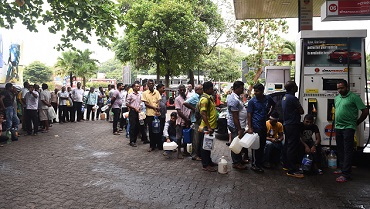The Australian Alert Service is the weekly publication of the Australian Citizens Party.
It will keep you updated on strategic events both in Australia, and worldwide, as well as the organising activities of the Citizens Party.
To subscribe to the Australian Alert Service, it's easy, and it's secure.
Lead Editorial
22 June 2022
Vol. 24 No. 25
Unless governments commit to a massive economic expansion including an emergency reconstruction program, commensurate with the FDR’s New Deal or Curtin and Chifley’s wartime mobilisation, millions will be consigned to depression-induced poverty and death.
Neoliberal economic schemes established a pathway to extend the life of the existing economic system without addressing the economic crisis and without enlisting new engines of growth—but by parasitising existing functions.
To be at its most productive, economics must focus not on extracting maximum profit from minimum expenditure, but on creating and channelling economic “free energy” into the harnessing of new technologies, new resources and new industries across new frontiers. This is only achieved by stimulating scientific breakthroughs, discovery and exploration, by nurturing the minds of the citizenry with a fast-developing economy anchored to a national mission and fostering a rich social and cultural environment.
The neoliberal era, which has squeezed the last ounces of blood from the dying system, is now over. The only remaining question is whether we let nations go down with it by refusing to overhaul our economic framework, or launch an economic revolution.
Take the case of Sri Lanka. The policies which have ruined it, and countless other developing countries expected to be hot on Sri Lanka’s tail in the debt default queue, are the very same that are now ripping the rug out from under Australia’s economy. Read our latest media release on p. 3 on the deliberate destruction of Australia’s energy production capacity, which is sabotaging the prospects of economic revival.
An International Monetary Fund team arrived in Colombo on 20 June to discuss a bailout, but any cash is months away and entirely dependent on Sri Lanka accepting more of the “reforms” that put it in its current condition. A 26 May IMF statement said discussions are “focused on restoring fiscal sustainability ... ensuring credibility of the monetary policy and exchange rate regimes; preserving financial sector stability; and structural reforms [an IMF euphemism for cuts in living standards]”. Other multilateral lenders are holding off until the IMF’s review, but Russia, China and Japan have stepped in to help. The country, which in April suspended payments on foreign debt, has just run out of fuel, putting the economy and people’s lives on hold. Civil servants have been told to work from home; schools have been closed and riots are erupting. Three ships full of oil anchored in port await the government obtaining US dollars for payment; ongoing blackouts are expected to reach 15 hours a day. For months there have been no foreign reserves to pay for imported medicines, which are now being rationed. Increased prices are hitting hard, especially on inputs, from oil to fertiliser.
The World Bank has noted a dozen developing economies on the cusp of default; Bloomberg on 23 May reported that global markets see Sri Lanka as “a bellwether for a raft of potential defaults across the developing world”.
But this is just one factor in the chaos sweeping financial markets—another symptom of the dying economic system. Speculative bubbles much bigger than 1929 or 2008 are about to burst at the same time as the brakes are put on the already shuttering real economy by rising interest rates. The US Federal Reserve’s latest 0.75 per cent rate rise is a marker for what is to come, threatening everyone, from mortgage holders to QE-addicted banks. Even worse than the foreign debts of most countries are bloated central bank balance sheets, margin debts of hedge funds, highly leveraged corporate debts, and speculative contracts built upon those and every other kind of debt. Without a program to deflate these bubbles in an orderly way, economies and nations will be wiped out by this debt tsunami, dwarfing Sri Lanka and other sovereign debt concerns. The “financial engineering” that is looting the Sri Lankas of the world—to sustain the hopelessly bankrupt financial order—must end now!
In this issue:
- Stop the madness! Return to public electricity systems
- Industry Commission Energy Generation and Distribution report, 1991
- Part Four: The final blow against Australian participation in the BRI
- USA and ‘allies’ outline Asia-Pacific Cold War plans at Shangri-La Dialogue
- Most of world has better agenda than G7 and NATO do
- ‘Revolutionary, tectonic shifts’ in world and its economy
- US states demand public banks to ‘address market failures’
- The public postal bank solution
- Project Victoria: the plot that looted a state’s assets
Click here for the archive of previous issues of the Australian Alert Service








